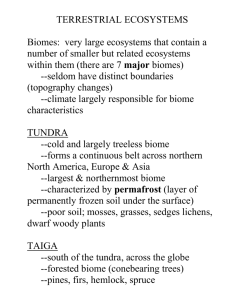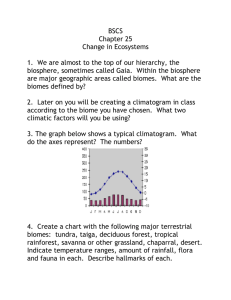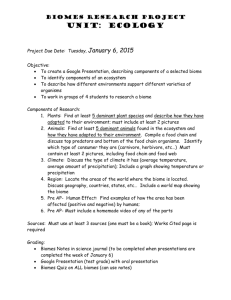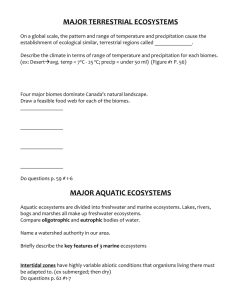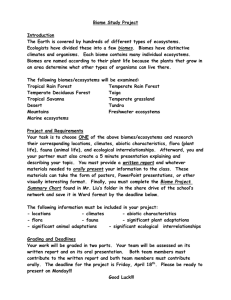Instructor`s Manual to accompany Principles of Life
advertisement
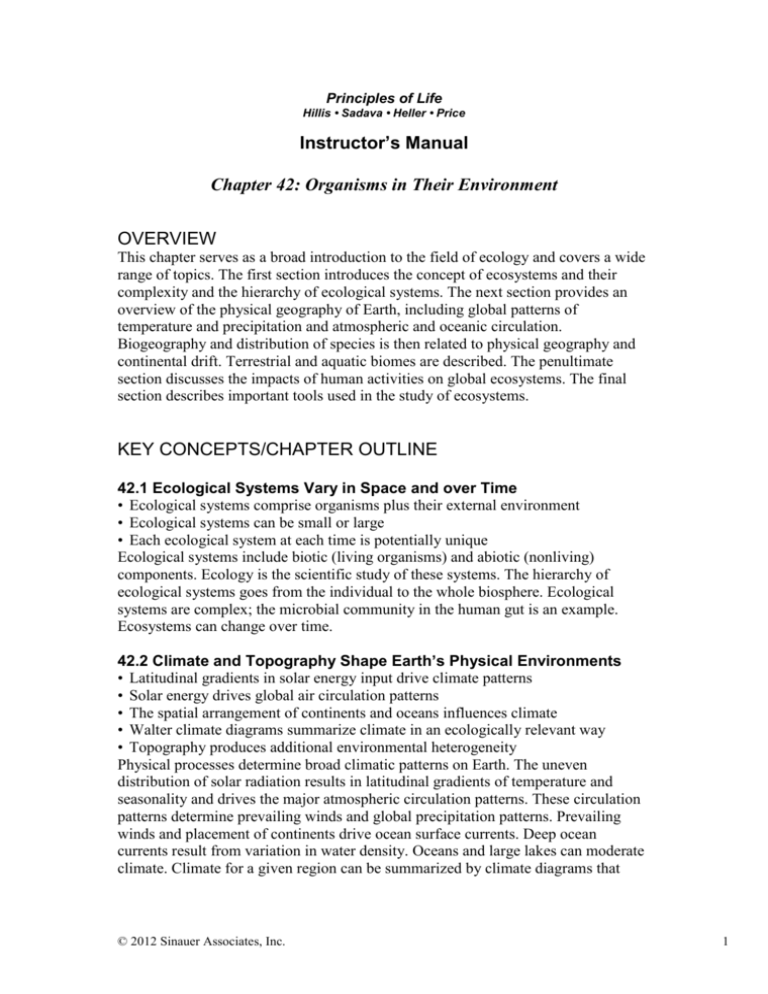
Principles of Life Hillis • Sadava • Heller • Price Instructor’s Manual Chapter 42: Organisms in Their Environment OVERVIEW This chapter serves as a broad introduction to the field of ecology and covers a wide range of topics. The first section introduces the concept of ecosystems and their complexity and the hierarchy of ecological systems. The next section provides an overview of the physical geography of Earth, including global patterns of temperature and precipitation and atmospheric and oceanic circulation. Biogeography and distribution of species is then related to physical geography and continental drift. Terrestrial and aquatic biomes are described. The penultimate section discusses the impacts of human activities on global ecosystems. The final section describes important tools used in the study of ecosystems. KEY CONCEPTS/CHAPTER OUTLINE 42.1 Ecological Systems Vary in Space and over Time • Ecological systems comprise organisms plus their external environment • Ecological systems can be small or large • Each ecological system at each time is potentially unique Ecological systems include biotic (living organisms) and abiotic (nonliving) components. Ecology is the scientific study of these systems. The hierarchy of ecological systems goes from the individual to the whole biosphere. Ecological systems are complex; the microbial community in the human gut is an example. Ecosystems can change over time. 42.2 Climate and Topography Shape Earth’s Physical Environments • Latitudinal gradients in solar energy input drive climate patterns • Solar energy drives global air circulation patterns • The spatial arrangement of continents and oceans influences climate • Walter climate diagrams summarize climate in an ecologically relevant way • Topography produces additional environmental heterogeneity Physical processes determine broad climatic patterns on Earth. The uneven distribution of solar radiation results in latitudinal gradients of temperature and seasonality and drives the major atmospheric circulation patterns. These circulation patterns determine prevailing winds and global precipitation patterns. Prevailing winds and placement of continents drive ocean surface currents. Deep ocean currents result from variation in water density. Oceans and large lakes can moderate climate. Climate for a given region can be summarized by climate diagrams that © 2012 Sinauer Associates, Inc. 1 show average temperature and precipitation over a year. Topography can also impact climate (e.g., mountains form rain shadows). 42.3 Physical Geography Provides the Template for Biogeography • Similarities in terrestrial vegetation led to the biome concept • The biome concept can be extended to aquatic environments Physical factors, in part, determine the distributions of species on Earth. Biogeography is the study of species distributions and the underlying causes of the observed distributions. Biomes are distinct physical environments with ecologically similar species. Terrestrial biomes are determined largely by temperature and precipitation patterns and have characteristic vegetation types. Organisms in the same biome type in different parts of the world have similar adaptations, even though they may not be related phylogenetically (convergent evolution). The biome concept is extended to aquatic environments, with salinity, water depth, and current being the defining characteristics. 42.4 Geological History Has Shaped the Distributions of Organisms • Barriers to dispersal affect the distributions of species • The movement of continents accounts for biogeographic regions • Phylogenetic methods contribute to our understanding of biogeography Species distributions are also influenced by geologic history and continental drift. The distribution of phylogenetically related biotas can be understood based on the configuration and movement of continents and Pleistocene glaciation history. This was first recognized by Alfred Russel Wallace, whose observations led to the concept of biogeographic regions. Phylogenetic trees can also be combined with biogeographic knowledge to further our understanding of modern species distributions. 42.5 Human Activities Affect Ecological Systems on a Global Scale • Human-dominated ecosystems are more uniform than the natural ones they replace • Human activities are simplifying remaining natural ecosystems • Human-assisted dispersal of species blurs biogeographic boundaries Human activities are now altering ecosystems on a global scale, leading some to suggest a new geological period called the “Anthropocene.” Human-dominated systems, such as urban and agricultural lands, now cover about half of Earth’s land surface. These systems have fewer species and less complexity than natural ecosystems. In agriculture, monocultures are planted and diversity of crop species is low. Natural ecosystems are also impacted by habitat fragmentation, pollution, and overexploitation of wild species. Humans move species around the globe, which is causing homogenization of the biotas that evolved over long periods of isolation. 42.6 Ecological Investigation Depends on Natural History Knowledge and Modeling • Models are often needed to deduce testable predictions with complex systems Ecologists use the same methods of scientific inquiry that are used in other fields, but the complexity of ecosystems makes certain tools particularly useful. Natural history observations (not part of formal hypothesis-testing investigations) are © 2012 Sinauer Associates, Inc. 2 essential to our understanding of ecosystem functioning and are also useful in formulating questions and hypotheses and designing ecological experiments. Computer models are useful in modeling the complexity of ecosystems and making predictions. The models incorporate many natural history observations. LECTURE OUTLINE Chapter 42 Opening Question Why did the rangeland restoration method that worked in Europe fail to work in the Borderlands? Concept 42.1 Ecological Systems Vary in Space and over Time Physical geography—study of the distribution of Earth’s climates and surface features Biogeography—study of the distributions of organisms Abiotic components of the environment—nonliving Biotic component—living organisms An ecological system—one or more organisms plus the external environment with which they interact Ecology—term coined by Ernst Haeckel in 1866; made it a legitimate scientific subject and emphasized its relevance to evolution because ecological interactions drive natural selection. System—a whole, comprising a set of interacting parts; neither the parts nor the whole can be understood without taking account of the interactions. Ecological systems can include any part of the biological hierarchy from the individual to the biosphere. Each level brings in new interacting parts at progressively larger spatial scales. FIGURE 42.1 The Hierarchy of Ecological Systems Population—group of individuals of the same species that live, interact, and interbreed in a particular area at the same time. Community—assemblage of interacting populations of different species in a particular area. Ecosystem—community plus its abiotic environment Biosphere—all the organisms and environments of the planet (LINK Concepts 15.2 and 15.3 The population is the unit of evolution) Generally, large ecological systems tend to be more complex and have more interacting parts. But small systems can also be complex: © 2012 Sinauer Associates, Inc. 3 The human large intestine is densely populated with hundreds of microbial species. The gut environment provides stable conditions and ample nutrients. The microbial species interact with each other and with their environment in many complex ways. At any given time, an ecological system is potentially unique. In the human gut, the microbial species vary from person to person and with diet. The host’s genotype and diet affect the gut environment from the bacterial point of view; and the bacteria influence their environment, which includes the host. Some health disorders may be treatable by manipulating the gut bacterial community. (LINK Figure 12.7 Scientists can analyze complex microbial ecosystems by sequencing DNA present in environmental samples) FIGURE 42.2 The Microbial Community of the Human Gut Depends on the Host’s Diet Concept 42.2 Climate and Topography Shape Earth’s Physical Environments Variation in physical environments results from atmosphere and ocean circulation patterns and geological processes. Weather—the state of atmospheric conditions in a particular place at a particular time Climate—average conditions and patterns of variation over longer periods Adaptations to climate prepare organisms for expected weather patterns. Earth receives uneven inputs of solar radiation due to its spherical shape and tilt of its axis as it orbits the sun. Subsequent results in temperature variation: • Air temperatures decrease from low to high latitudes. • High latitudes experience more seasonality—greater fluctuation over the course of a year. FIGURE 42.3 Solar Energy Input Varies with Latitude FIGURE 42.4 The Tilt of Earth’s Axis of Rotation Causes the Seasons Solar energy inputs are always greatest in the equatorial region, which drives global patterns of air circulation. Hadley cells: The tropical air is warmed, rises, and then cools adiabatically (an expanding gas cools). The rising warm air is replaced by surface air flowing in from the north and south. © 2012 Sinauer Associates, Inc. 4 The cooling air sinks at 30°N and 30°S. FIGURE 42.5 Global Atmospheric Circulation Other circulation cells form at the mid-latitudes and at the poles. The circulation patterns influence prevailing winds and precipitation patterns. Rising warm tropical air releases lots of moisture as rainfall. The sinking air at 30°N and 30°S is dry—most of the great deserts are at these latitudes. Prevailing winds are deflected by the rotation of the Earth—the Coriolis effect. FIGURE 42.6 Direction of Prevailing Surface Winds Prevailing winds drive the major ocean surface currents. Example: northeast trade winds drive water to the west; when it reaches a continent it is deflected northward until the westerlies drive the water back to the east. (VIDEO 42.1 El Niño and global oceanic circulation and temperature) FIGURE 42.7 Ocean Currents Deep ocean currents are driven by water density differences. Colder, saltier water is more dense and sinks to form deep currents. Deep currents regain the surface in areas of upwelling, completing a vertical ocean circulation. Oceans and large lakes moderate climate because water has a high heat capacity. Water temperature changes slowly as it exchanges heat with the air. Poleward-flowing ocean currents carry heat from the tropics toward the poles, moderating climate at higher latitudes. Example: the Gulf Stream warms northern Europe. Climate diagram—superimposed graphs of average monthly temperature and precipitation throughout a year. The axes are scaled so that precipitation is adequate for plant growth when the precipitation line is above the temperature line. The growing season occurs when temperatures are above freezing and there is enough precipitation. (APPLY THE CONCEPT Climate shapes Earth’s physical environments) FIGURE 42.8 Walter Climate Diagrams Summarize Climate in an Ecologically Relevant Way Earth’s topography also influences climate. As you go up a mountain, air temperature drops by about 1°C for each 220 m of elevation. When prevailing winds bump into mountain ranges, the air rises up, cools, and releases moisture. The now-dry air descends on the leeward side. © 2012 Sinauer Associates, Inc. 5 This results in a dry area on the leeward side, called a rain shadow. (ANIMATED TUTORIAL 42.1 Rain Shadow) FIGURE 42.9 A Rain Shadow Topography also influences aquatic environments: Flow velocity depends on slope. Water depth determines gradients of many abiotic factors, including temperature, pressure, light penetration, and water movement. Concept 42.3 Physical Geography Provides the Template for Biogeography Organisms must be adapted to their physical environments. For example, a plant that has no means of conserving water cannot thrive in a desert. Species are found only in environments they can tolerate. (LINK Concept 28.3 Some adaptations of plants to challenging climatic conditions) Early naturalist–explorers began to understand how the distribution of Earth’s physical environments shapes the distribution of organisms. Their observations revealed a convergence in characteristics of vegetation found in similar climates around the world. Biome—a distinct physical environment inhabited by ecologically similar organisms with similar adaptations. Species in the same biome in geographically separate regions display convergent evolution of morphological, physiological, or behavioral traits. (ANIMATED TUTORIAL 42.2 Biomes) Terrestrial biomes are distinguished by their characteristic vegetation. Distribution of terrestrial biomes is broadly determined by annual patterns of temperature and precipitation. These factors vary along both latitudinal and elevational gradients. FIGURE 42.10 Temperature and Precipitation Gradients Determine Terrestrial Biomes FIGURE 42.11 Global Terrestrial Biomes Other factors, especially soil characteristics, interact with climate to influence vegetation. Example: Southwestern Australia has Mediterranean climate with hot, dry summers and cool, moist winters. The vegetation is woodland/shrubland, but no succulent plants are here. The soils are nutrient-poor, and there are frequent fires. Succulents are easily killed by fires. © 2012 Sinauer Associates, Inc. 6 FIGURE 42.12 Same Biome, Different Continents (Part 3) The biome concept is also applied to aquatic environments. Aquatic biomes are determined by physical factors such as water depth and current, temperature, pressure, salinity, and substrate characteristics. TABLE 42.1 Major Aquatic Biomes The primary distinction for aquatic biomes is salinity: freshwater, saltwater, and estuarine biomes. Salinity determines what species can live in the biome, depending on their ability to osmoregulate. In streams, current velocity is important. Organisms must have adaptations to withstand flow. Current also impacts the substrate—whether rocky, sandy, silty, etc. Substrate also determines what species are present. Still-water biomes (lakes and oceans) have zones related to water depth. Nearshore regions (littoral or intertidal) are shallow, impacted by waves and fluctuating water levels. Distinct zonation of species is common. Photic zone—depth to which light penetrates; photosynthetic organisms are restricted to this zone. (VIDEO 42.2 Portrait of a marine ecosystem: A coral reef in the Philippines) FIGURE 42.13 Water-Depth Zones Aphotic zone is too deep for light penetration. Benthic zone—lake or ocean bottom Water pressure increases with depth. Organisms in the deepest oceans (abyssal zone) must have adaptations to deal with high pressure, low oxygen, and cold temperatures. Concept 42.4 Geological History Has Shaped the Distributions of Organisms Alfred Russel Wallace studied species distributions in the Malay Archipelago and observed dramatically different bird faunas on two neighboring islands, Bali and Lombok. The differences could not be explained by soil or climate. FIGURE 42.14 Wallace’s Line © 2012 Sinauer Associates, Inc. 7 He suggested that the deep channel between the islands would have remained full of water (and a barrier to movement of terrestrial animals) during the Pleistocene glaciations when sea level dropped. Thus, the faunas on either side of the channel evolved mostly in isolation over a long period of time. Wallace’s observations led him to divide the world into six biogeographic regions. They contain distinct assemblages of species, many of which are phylogenetically related. Many of the boundaries correspond to geographic barriers to movement: bodies of water, extreme climates, mountain ranges. FIGURE 42.15 Movement of the Continents Shaped Earth’s Biogeographic Regions Boundaries of some biogeographic regions are related to continental drift. Example: southern beeches (Nothofagus) are found in South America, New Zealand, Australia, and some south Pacific islands. The genus originated on the southern supercontinent Gondwana during the Cretaceous and was carried along when Gondwana broke apart. FIGURE 42.16 Distribution of Nothofagus Biotas of the seven biogeographic regions developed in isolation throughout the Tertiary (65 to 1.8 mya), when extensive radiations of flowering plants and vertebrates took place. (LINK Figure 18.12 The movements of the continents over geological history) Continental movement has recently eliminated some barriers, allowing biotic interchange. Examples: when India collided with Asia about 45 mya, and when a land bridge formed between North and South America about 6 mya. (LINK Concept 16.1 Review effects of barriers to dispersal on speciation) Biogeographers use phylogenetic information, along with the fossil record and geological history, to study modern distributions of species. Geographic areas are superimposed on phylogenetic trees. The sequence and timing of splits in the phylogenetic tree are compared with sequence and timing of geographic separations or connections. (APPLY THE CONCEPT Geological history has shaped the distributions of organisms) Concept 42.5 Human Activities Affect Ecological Systems on a Global Scale Human activities are altering ecological systems on a global scale. Some have suggested we are entering a new geological period, the “Anthropocene.” © 2012 Sinauer Associates, Inc. 8 We are changing the distributions of organisms, vegetation, and topography, as well as Earth’s climate. Human-dominated ecosystems, such as croplands, pasturelands, and urban settlements now cover about half of Earth’s land area. These ecosystems have fewer interacting species and are less complex. In agricultural lands, monocultures replace species-rich natural communities. Diversity of crops planted is also very low: 19 crops comprise 95% of total global food production. Agricultural systems are more spatially and physically uniform than natural ecological systems. FIGURE 42.17 Human Agricultural Practices Produce a Uniform Landscape Human activities also reduce complexity in natural ecosystems: • Damming and channelization of rivers • Pollution and habitat fragmentation • Overexploitation of wild species • Introductions of new species (VIDEO 42.3 Portrait of a rainforest ecosystem: Amazon of South America and other locations) (VIDEO 42.4 The exotic invasive plant kudzu, Pueraria lobata) Humans move species throughout the globe, sometimes deliberately, sometimes inadvertently. Human-assisted biotic interchange is homogenizing the biota of the planet, blurring the spatial heterogeneity in species composition that evolved during long periods of continental isolation. Concept 42.6 Ecological Investigation Depends on Natural History Knowledge and Modeling Natural history—observation of nature outside of a formal, hypothesis-testing investigation—provides important knowledge about ecosystems. These observations are often the source of new questions and hypotheses and aid in design of ecological experiments. Computer models are important tools in the study of ecosystems. Natural history knowledge is used to build these models. Example: rangeland grasses are affected by other plants and herbivores, soil fertility, climate, and fire. To predict the effect of removing cattle to bring back grasses, all these interactions must be known. Answer to Opening Question Grasslands in different parts of the world differ in significant ways. © 2012 Sinauer Associates, Inc. 9 Grasslands occupy a range of climatic conditions from moist to very arid. In Europe and eastern North America, pastures were once forests; “resting the range” and managing herd size can restore much of the ecosystem. Temperate grasslands of midwestern North America, Eurasia, South America, and African savannas have long histories of evolution with grazing mammals. It is not clear why removal of cattle has not restored grasslands in the U.S.–Mexico Borderlands; it is an area of active research. (VIDEO 42.5 Portrait of a grassland ecosystem: The Serengeti Plains of Africa) FIGURE 42.18 Harmonious Grazers KEY TERMS abiotic abyssal zone adiabatically aphotic zone benthic zone biogeographic regions biogeography biome biosphere biotic biotic interchange climate climate diagram community currents ecological system ecology ecosystem Hadley cells intertidal landscapes limnetic littoral zone natural history pelagic zone photic zone physical geography population seasonality topography weather zone © 2012 Sinauer Associates, Inc. 10



